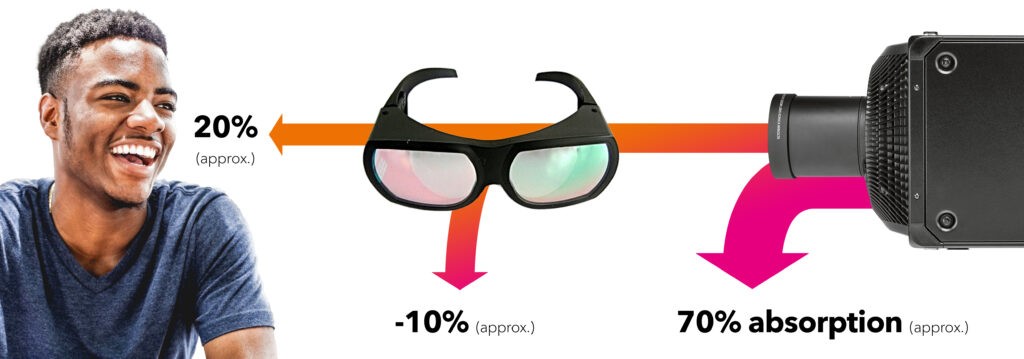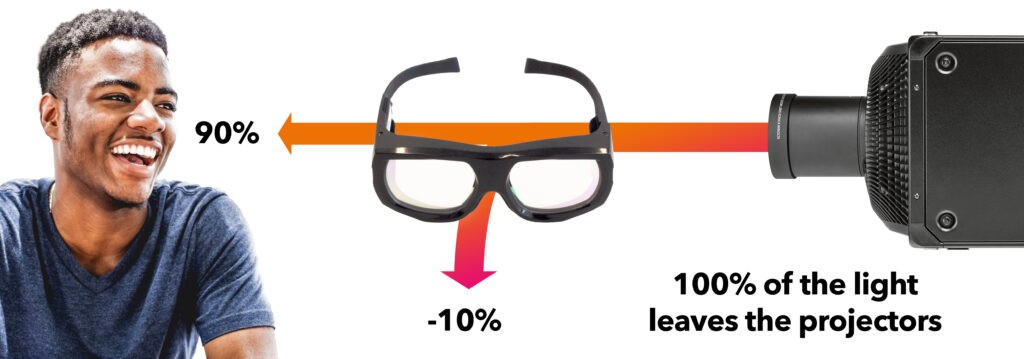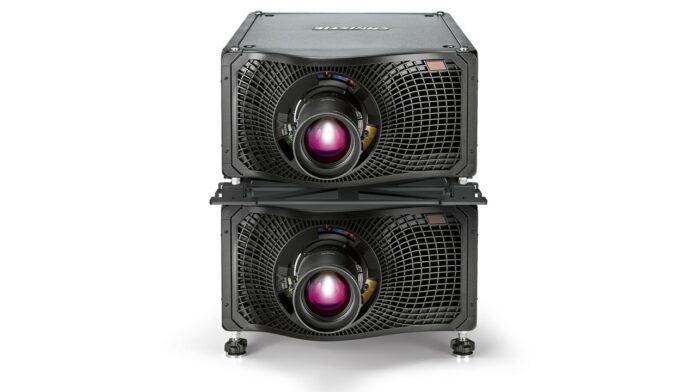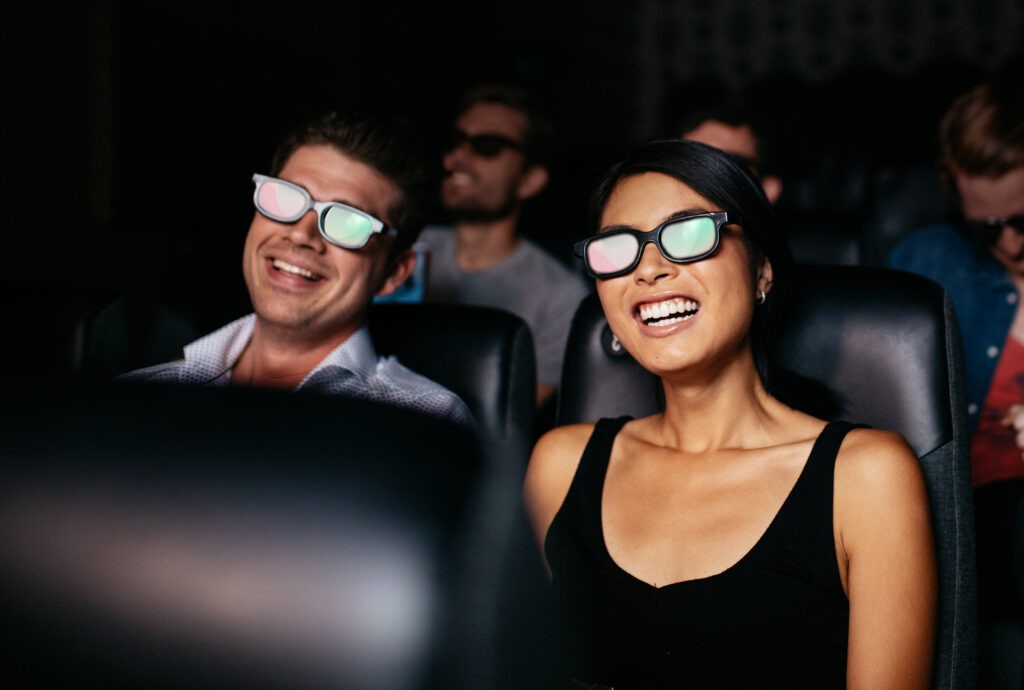New projection technology promises a brighter future for 3D attractions
by Joe Kleiman
Christie’s newest RGB laser projector is designed for brighter, better 3D attractions. The Mirage SST-6P began rolling out in March 2021 as part of Christie’s expanding line of RGB laser projectors. It is engineered to serve the 3D attractions market – allowing operators to benefit from new advances in laser projection and 3D technology, higher frame rate, resolution and color saturation – while leaving behind the issues and drawbacks of older systems.
This promises to be good news for operators, creatives, technical designers – and audiences. 3D projection has a long history in themed entertainment, though frequently plagued by issues such as dim visuals and viewer discomfort. The new Mirage SST-6P has the power to transform it into a considerably brighter, more colorful and engaging experience than before. Whether a system upgrade or a new installation, keeping an attraction’s technology up to date and engaging is an important aspect of attracting new and repeat visits, while helping to streamline issues of maintenance and operations.
The Mirage SST-6P projects a 4K 3D image at up to 120 frames per second, delivered through two RGB laser feeds. The lasers and special glasses create a vividly bright image on screen, with an expansive array of colors. This configuration also promises greater guest comfort. Single-head projector solutions are required to sequentially flash left and right images, and this can be a source of the eye fatigue and headaches that some guests encounter in 3D attractions. The Mirage SST-6P is designed to produce a more comfortable visual experience by delivering the left- and right-eye images to both eyes simultaneously.
There’s a case to be made for investing in better 3D: It’s popular, and it pops. 3D shows are proven crowd pleasers for entertainment and education alike. 3D experiences continue to engage and thrill audiences in the form of interactive dark rides and 4D shows in theme parks, cinematic exhibitions in giant screen theaters, planetarium shows, theaters in zoos and aquariums, immersive attractions and more. The 3D effect immerses guests in the storyline, inviting them to become part of the story. In a 3D dark ride, using screens instead of physical props and spaces can reduce an attraction’s footprint and overall cost. Many modern 3D dark rides also include interactive elements, such as target shooting.
Historically, 3D is a medium that fascinates and endures, despite its technical and operational shortcomings. And now, the Mirage SST-6P is poised to do away with those drawbacks and pave the way for a new generation of 3D crowd pleasers. Strong attendance and efficiency are especially important for owners and operators following the closures and restrictions imposed on parks and attractions during the COVID-19 pandemic and its resulting financial impact. Now may be the ideal time to check out what the Mirage SST-6P can do.
Upgrading an existing 3D attraction likely means replacing an aging, lamp- based projection system. According to Larry Paul, Executive Director, Technology and Custom Solutions for Christie, “The traditional color-interference filter (sometimes called ‘color- comb’) lamp-based systems need replacing, so operators need new technology. The Mirage SST-6P RGB laser projection system is the lampless replacement that will breathe new life into 3D attractions, offering many performance improvements.”
Saying goodbye to dim on-screen visuals
The “RGB” in RGB laser stands for red, green and blue, the three primary-colored lasers used to generate light. This is a key differentiator from the more commonly known laser phosphor projection, as well as from lamp-based projection. Moving to RGB laser projection offers numerous benefits over other digital projection systems, including much longer lasting brightness, reduced maintenance, a lower cost of operation, and improved color and contrast.

Paul explained the brightness factor. The Mirage SST-6P includes two RGB laser light sources, projected from two separate 4K projector heads typically stacked one on top of the other. The red, green and blue primaries for the right- and left-eye images are projected at slightly different wavelengths – resulting in six laser RGB primaries, hence 6-Primary projection – and each lens of a pair of color-filtering passive 3D glasses matches these wavelengths, ensuring the proper image is seen by each eye. Because there are no 3D filters on the projector itself, 100% of the light leaves each projector. Only about 10% of the light is absorbed by glasses for each eye. The result is an extremely bright image, with 90% of the light from each projector going to the correct eye. This is a vast improvement over the most common 3D technology used in the attractions industry today, color-interference filter dual lamp-based projection systems. There, roughly 70% of the light is absorbed by the filters in the projectors and a further 10% in the glasses so approximately only 20% of the light reaches the eye.


The 90% light retention results in a much brighter, clearer image with more vivid colors. Color is measured by a color gamut, the range of colors visible to the human eye that can be reproduced by a device. The color gamut of the Mirage SST-6P surpasses both the International Telecommunication Union’s Rec. 709 and Digital Cinema Initiative’s DCI-P3 color gamuts, standards for the maximum colors visible from a digital projector. A fuller color palette empowers creating more realistic and vibrant guest experiences.
Installation and integration friendly
Specifications indicate that the technology is compatible with white or grey screens – silver is not needed – and therefore lends itself to the more complex screens and setup requirements of attractions. It is compatible with ultra-short-throw lenses for tight spaces. It works in multi-projector arrays to fill larger screens. The projection system has Christie Twist built in for warping and blending and is compatible with Christie Mystique, the company’s automated camera-based alignment software. This software automates warping and blending to facilitate projection onto curved and unconventionally shaped screens.
The Mirage SST-6P system is a dual projection solution with each unit consisting of three main parts: a projector head, remote RGB laser light source and compact chiller. The small size and light weight of the projector head (just 113lbs /51kg) and its ability to be installed at absolutely any angle facilitate placing the projector where it should ideally go. It is illuminated by the remote RGB light source, via a fiber-optic cable. And the light source is cooled by a compact chiller that can be installed away from guests for easy heat and sound management. Because the projection system utilizes remote lasers, the loud noise of a heat exhaust fan from the projector head is no longer a factor, so guests are unaware of the projection system’s presence.
Higher frame rates = more realism
The Christie Mirage SST-6P doesn’t just project in 3D, but it does so at a high frame rate (HFR). “When matched properly with high frame rate,” says Paul, “3D works great. Right now, the emphasis in the industry is on spatial resolution [pixels], but temporal resolution [frame rate] is the next big area of exploration. Because Hollywood is slow with introducing new technology, theme parks and video games will lead the market with high frame rate experiences.”
Movies, whether in cinema or attractions, are based on a series of individual images or frames stitched together. As they are shown one after another by the projector, they create the illusion of motion. The speed at which they progress, or frame rate, impacts the amount of realism the viewer sees, with higher frame rates eliminating artifacts such as motion blur. The result is a more realistic, immersive experience.
In the pre-digital era, it was standard for motion pictures to run at 24 frames per second (fps), the minimum speed needed to synch sound to film. The Mirage SST-6P can project images in 4K resolution at 120 frames per second per eye in 3D and, with the Mirage Pro upgrade, an astonishing 480 fps per eye in 2K resolution that scales to fill the 4K chip.
“4K 3D projection at 120 frames per second was something we jumped on and invested in early, with our partners helping us along the way,” says Paul. “We knew from the start that this would become part of a storyteller’s medium.” Of course, technical quality is not an end in itself. The projector is a tool and it’s important to have appropriate and quality content for your audience. As Paul puts it: “Good content will not fix a bad projector, and a good projector will not fix bad content.” But in this highly creative industry, storytellers always step up to explore the possibilities of a great new tool. The versatility of the Christie Mirage SST-6P supports better on-screen imagery, which should interest anyone with a vision to create media-based attractions.
The overarching goal is to combine technology with quality content in a way where the audience is not aware of the 3D illusion, but immersed within it. “When we speak with customers,” says Paul, “we like to find out what challenges they’re trying to overcome, what we can do to make life easier for them. We love that we have systems that can accomplish what the customers want them to. They turn it on and see projector performance like they’ve never encountered and an experience like they’ve never seen before. To the audience, the immersion itself is a secret.” • • •








